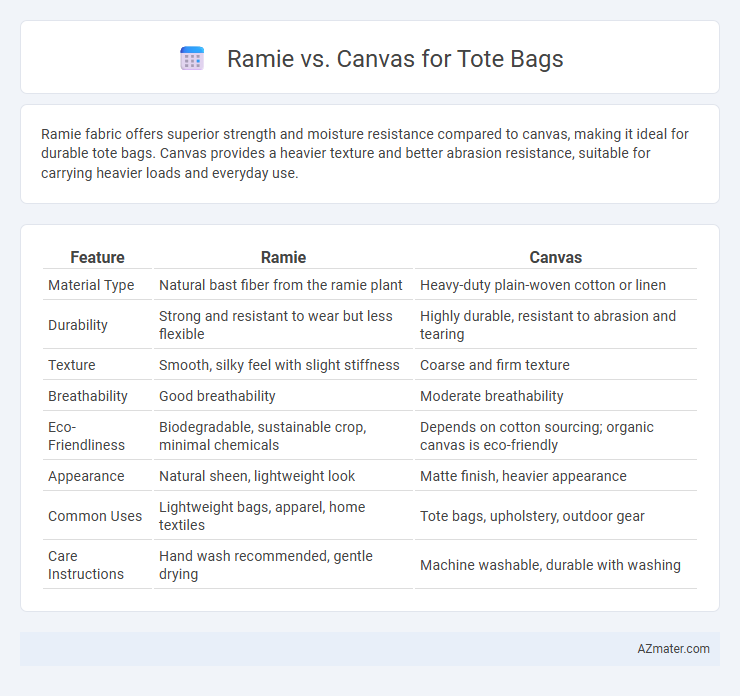Ramie fabric offers superior strength and moisture resistance compared to canvas, making it ideal for durable tote bags. Canvas provides a heavier texture and better abrasion resistance, suitable for carrying heavier loads and everyday use.
Table of Comparison
| Feature | Ramie | Canvas |
|---|---|---|
| Material Type | Natural bast fiber from the ramie plant | Heavy-duty plain-woven cotton or linen |
| Durability | Strong and resistant to wear but less flexible | Highly durable, resistant to abrasion and tearing |
| Texture | Smooth, silky feel with slight stiffness | Coarse and firm texture |
| Breathability | Good breathability | Moderate breathability |
| Eco-Friendliness | Biodegradable, sustainable crop, minimal chemicals | Depends on cotton sourcing; organic canvas is eco-friendly |
| Appearance | Natural sheen, lightweight look | Matte finish, heavier appearance |
| Common Uses | Lightweight bags, apparel, home textiles | Tote bags, upholstery, outdoor gear |
| Care Instructions | Hand wash recommended, gentle drying | Machine washable, durable with washing |
Introduction to Ramie and Canvas Fabrics
Ramie is a natural fiber derived from the stalks of the Chinese nettle plant, prized for its strength, durability, and resistance to wrinkling and mildew. Canvas, typically made from cotton or linen, is a heavy-duty woven fabric known for its rugged texture and exceptional durability, making it a popular choice for tote bags that require sturdy construction. Both fabrics offer unique benefits: ramie provides a lustrous finish with natural antibacterial properties, while canvas offers versatility and ease of customization through printing and dyeing.
Origin and Production Differences
Ramie, a natural bast fiber derived from the stalks of the Chinese nettle plant, has been cultivated in East Asia for over 6,000 years, primarily in China, Brazil, and the Philippines. Canvas, traditionally made from cotton or linen, originated in ancient Egypt and later flourished in Europe, with production involving tightly woven, durable fabric ideal for heavy-duty applications. Ramie fibers require chemical processing to remove gums and refine texture, while canvas fabric production emphasizes dense weaving techniques for strength and longevity.
Durability: Ramie vs Canvas
Ramie fiber offers excellent tensile strength, making it highly durable and resistant to wear and tear, suitable for heavy loads in tote bags. Canvas, typically made from cotton or linen, provides superior abrasion resistance and flexibility, enhancing its durability for everyday use. Comparing durability, canvas tends to withstand rough handling better, while ramie excels in maintaining structural integrity over time under heavy stress.
Eco-Friendliness and Sustainability
Ramie fibers are highly eco-friendly due to their natural biodegradability and minimal water and pesticide requirements, making them a sustainable choice for tote bags. Canvas, typically made from cotton, has a higher environmental impact because cotton cultivation demands significant water and pesticide use, but organic canvas offers a more sustainable alternative. Choosing ramie tote bags supports reduced ecological footprint and promotes sustainable fashion practices.
Texture and Aesthetic Appeal
Ramie fabric features a natural luster and a slightly rough texture, offering a rustic yet elegant appearance for tote bags. Canvas provides a sturdy, coarse texture with a matte finish, lending a timeless and utilitarian aesthetic. The glossy sheen of ramie enhances visual appeal for fashion-forward designs, while canvas delivers durability and a classic, rugged look.
Weight and Carrying Comfort
Ramie fabric, known for its lightweight yet sturdy nature, offers enhanced carrying comfort for tote bags compared to traditional canvas. Canvas tends to be heavier, which can add bulk and strain during extended use, whereas ramie's breathable fibers reduce shoulder fatigue. Choosing ramie for tote bags combines durability with a lighter feel, making it ideal for everyday carrying needs.
Water and Stain Resistance
Ramie fabric offers moderate water resistance due to its natural fibers, but it tends to absorb stains more easily compared to canvas. Canvas, especially when treated or coated, provides superior water and stain resistance, making it a more durable option for everyday tote bags. For enhanced protection, canvas tote bags often incorporate waterproof liners or stain-resistant finishes, ensuring better longevity and easier maintenance.
Maintenance and Care Requirements
Ramie tote bags require minimal maintenance due to their natural resistance to mildew and insects, making them easy to clean with mild soap and water without frequent washing. Canvas tote bags demand more regular care, including spot cleaning and occasional machine washing to prevent dirt buildup and maintain fabric integrity. Proper air drying is essential for both materials to avoid shrinkage and preserve durability over time.
Cost Comparison: Ramie vs Canvas Tote Bags
Ramie tote bags generally cost more than canvas bags due to the labor-intensive harvesting and processing of ramie fibers, which results in higher production expenses. Canvas tote bags are more affordable, benefiting from mass production and the widespread availability of cotton, making them a cost-effective option for both manufacturers and consumers. When choosing between ramie and canvas, budget-conscious buyers often opt for canvas, while those seeking durability and eco-friendliness may justify the premium price of ramie bags.
Best Uses for Ramie and Canvas Tote Bags
Ramie tote bags excel in durability and natural moisture-wicking properties, making them ideal for eco-friendly shopping and beach bags where breathability and lightweight strength are crucial. Canvas tote bags offer superior sturdiness and can support heavier loads, perfect for everyday groceries, book bags, and promotional totes requiring a robust, long-lasting material. Choosing between ramie and canvas depends on the specific use; ramie suits lightweight, breathable needs, while canvas withstands rougher wear and tear for heavier cargo.

Infographic: Ramie vs Canvas for Tote Bag
 azmater.com
azmater.com